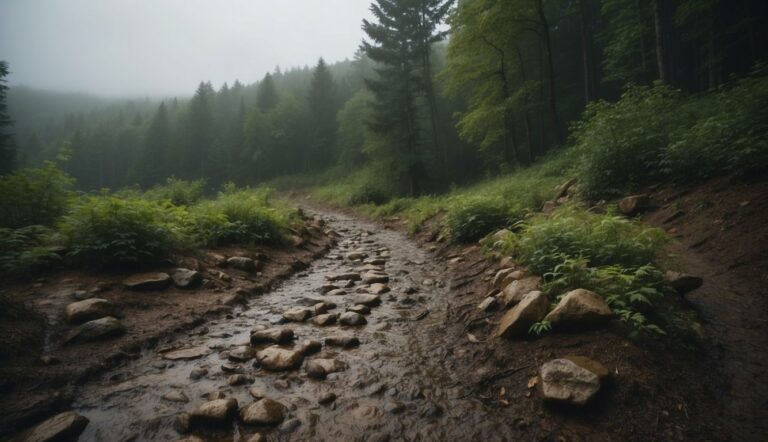Setting Realistic Goals in Trail Running: Strategies for Success
Setting realistic goals is a cornerstone of trail running, a sport that often pushes runners to their physical and mental limits. As a UESCA certified running coach with extensive experience, I’ve learned that embracing measurable and achievable objectives is critical for growth and satisfaction in this sport. It’s not just about the distance covered or the elevation climbed, but about tailoring these challenges to your individual capabilities and resources.
In my practice, I emphasize the importance of setting goals that are not only challenging but also within the realm of possibility. This approach helps trail runners stay motivated and avoid burnout. Whether you’re looking to complete your first 5K trail run or aiming to improve your 100K race time, the key is to establish benchmarks that guide your training while keeping you inspired.
Creating goals that align with your current fitness level, available training time, and personal life commitments can make all the difference in not only reaching but also enjoying your achievements. Trail running should be a journey of personal fulfillment, not frustration, and with the right goals, it can be a rewarding adventure that continually propels you forward.

Trail Running and Setting Realistic Goals
As a seasoned trail runner and UESCA certified running coach, my advice on goal setting is rooted in both experience and professional expertise. In trail running, specific, realistic goals are the cornerstone of improvement and enjoyment.
Defining a Realistic Goal for Trail Running
A realistic goal in trail running is one that aligns with your current running experience and capabilities. It should stretch your limits without being unattainable.
If you’re new to trail running, starting with a shorter distance, such as a 5k, would be sensible. More seasoned runners might aim for a marathon or a personal record in a familiar race.
Consider these factors when setting a realistic goal:
- Current fitness level: Your recent running history is a strong predictor for future performance.
- Work/life balance: Time available for training must be considered to avoid overcommitting.
- Previous injuries: If you have a history of injuries, a more conservative goal may be prudent.
- Terrain and conditions: Are you used to the trail’s elevation changes and technicality?
Short-term goals might include finishing a particular race without injury, while long-term goals could focus on running a trail marathon.
The Importance of Goal Setting in Trail Running
Setting goals in trail running provides direction and purpose to your training. Goals can be split into:
- Outcome goals: Achieving a specific finish time or placing.
- Process goals: Focusing on the components that lead to outcome goals such as consistent training.
Setting both types of goals ensures a balanced approach, keeps motivation high, and can lead to more sustainable running experience. Here’s how to prioritize:
- Set specific goals: “Run a sub-30-minute 5k” rather than “run faster”.
- Make them measurable and time-bound: This allows for tracking progress over time.
Remember, a goal without a plan is just a wish. Invest time in creating a structured training plan that supports your goal, and adjust as necessary based on your progress and any obstacles you may encounter.
Creating a Structured Training Plan
When crafting a structured training plan for trail running, it’s essential to align your regimen with your specific goals, acknowledge the various seasons which may affect your training, and include exercises that build strength and speed.
Tailoring Your Training to Your Goals
In my experience as a UESCA certified running coach, a training plan must start with clear, measurable, and achievable goals.
Whether you’re aiming for a 5K or a marathon, every plan should be customized to your current fitness level and the distances you aspire to run. For example, a beginner targeting a 5K race might start with shorter runs combined with walking, gradually building up to the full distance over several weeks.
Example Training Progression for a 5K:
- Weeks 1-2: Run 1 km, walk 1 km (repeat 2-3 times)
- Weeks 3-4: Run 2 km, walk 1 km (repeat 2 times)
- Weeks 5-6: Run 3 km, walk 0.5 km (repeat 2 times)
- Weeks 7-8: Run full 5 km at a comfortable pace
Seasonal Planning and Periodization
Adjusting your training with the seasons is crucial for peak performance and injury prevention. During winter, for example, my plans typically focus on building a strong base with lower intensity and higher volume.
As seasons change, I transition into more specialized training phases, such as pre-competition and competition, where intensity increases and volume decreases accordingly.
Seasonal Training Focus:
- Winter: Base building, easy runs, longer distances
- Spring: Transition, beginning speed work, moderate distances
- Summer: Peak training, high intensity, race-specific workouts
- Autumn: Recovery, lower intensity, maintenance
Incorporating Strength and Speed Work
It’s paramount to include strength and speed work in a trail running training plan to improve performance and reduce injury risk. I ensure that my clients engage in strength training exercises twice per week to build muscle and support joint health.
For speed work, interval training, such as hill repeats or tempo runs, is integrated weekly to improve cardiovascular fitness.
Weekly Strength and Speed Work Schedule:
- Monday: Strength training (e.g., squats, lunges, core exercises)
- Wednesday: Interval training (e.g., 4×4 minutes at a hard effort with recovery jogs in between)
- Friday: Strength training (e.g., deadlifts, push-ups, planks)
- Sunday: Long, slow distance run with periodic tempo intervals
Monitoring Progress and Staying Motivated

As a runner and UESCA certified coach, I can attest that setting goals in trail running is just the beginning. The real challenge lies in tracking your progress effectively and nurturing the mental fortitude to stay motivated through the ups and downs. Let’s dive into strategies that will help you stay on track and enjoy your trail running journey.
Tracking Mileage and Performance
Mileage and Performance Goals: Track your runs consistently to monitor your mileage and performance.
Use this simple table to log your weekly mileage and key performance metrics:
| Week | Total Mileage | Avg. Pace | Avg. Heart Rate | Elevation Gain |
|---|---|---|---|---|
| 1 | ||||
| 2 | ||||
| … |
Notice patterns in your stats to adjust your training. Achieving milestones, like a longer distance or a faster pace, should be celebrated to keep your motivation high.
The Role of Mental Strength and Perseverance
Building Mental Strength: Mental toughness is as critical as physical stamina. To stay motivated:
- Reflect on why you started trail running.
- Set small, manageable goals leading up to big races.
- Celebrate personal growth, no matter how small.
Perseverance: Despite setbacks, maintain a positive mindset. Recall past achievements and use them as fuel to persevere through challenging sessions or races.
Finding Joy in the Process
To truly stay motivated, find joy in every run. Whether it’s the serenity of the trails, the camaraderie with fellow runners, or the exhilaration of an intense heart rate surge, relishing these moments contributes to your love for the sport.
- Embrace challenging routes for the sense of accomplishment they provide.
- Appreciate the personal growth you experience with every run.
By focusing on these aspects of trail running, you will not only make steady progress but also ensure the journey is as rewarding as the destination.
Adjusting Goals Based on Performance and Experience

Setting achievable goals in trail running requires reflection on past performances and the understanding of personal limits. I guide my clients to adjust their objectives as they grow in skill and endurance.
Reevaluating Goals with a Running Coach or Community
Working with a coach, or seeking feedback from a running community, can provide an external perspective on goal setting. My role involves reviewing race results or training progress to identify performance barriers. Collaborative reevaluation often leads to setting new benchmarks that align with the runner’s evolving experience.
For example, if a running buddy consistently achieves a personal best, it may indicate readiness to tackle more ambitious goals. Conversely, persistent struggles or a plateau suggest a need for revised, possibly more incremental objectives.
Learning from Each Race and Training Cycle
Each race and training cycle is a learning experience that informs future goals.
Self-assessment is key; I encourage runners to analyze every aspect of their performance:
- What was their race completion time compared to their goal?
- Did they experience any unexpected issues during the race?
- How did their body feel throughout the training and race?
Based on these insights, adjustments might include:
| Previous Goal | Issue Encountered | Adjusted Goal |
|---|---|---|
| Finish a 100K trail race in under 12 hours | Insufficient hydration and nutrition | Improve hydration strategy; incrementally increase race pace |
| Run without injury for a full season | Experienced repetitive stress injuries | Incorporate cross-training and rest days into the program |
| Place in the top 10 of my age group | Performance affected by stress | Focus on mindfulness and recovery techniques to improve race day performance |
This systematic approach ensures that new goals are informed by real-world experience, making them both challenging and realistic.
Incorporating Recovery and Sustainable Practices

Incorporating recovery and sustainable practices into a trail running routine ensures longevity in the sport. I prioritize a balance between rigorous training and necessary rest, along with developing healthy habits for a sustainable running career.
Balancing Training with Adequate Rest
With the demands of trail running, it’s crucial to balance intense training days with appropriate rest. I design training schedules to include active recovery days following hard sessions. Here’s how I structure a typical week:
- Monday: Light cross-training or rest
- Tuesday: Tempo run
- Wednesday: Easy, conversational pace run
- Thursday: Rest or light yoga/stretching
- Friday: Interval workout
- Saturday: Long, slow distance run
- Sunday: Total rest or easy recovery run
This structure allows muscles to heal and fitness levels to improve without risking burnout or injury.
Healthy Habits for Longevity in Trail Running
To maintain a reliable routine in trail running, it’s crucial to cultivate healthy relationships with food and understand its role in recovery. I advise consuming a balanced diet rich in nutrients, which aids in repair and replenishment after runs. Here’s a simple guide on what to include:
| Meal Time | Focus |
|---|---|
| Pre-run | Carbohydrates for energy |
| Post-run | Protein for muscle recovery |
| Overall | Hydration and micronutrients |
By following these guidelines and listening to my body, I ensure that I am fueling my runs and recovery adequately, thereby fostering a sustainable relationship with trail running.
Leveraging Technology and Resources
In trail running, embracing the latest technology and resources can significantly enhance training and racing experiences. From apps that track performance to virtual races that offer community interaction, technology is a key ally.
Utilizing Apps and Gadgets for Enhanced Training
Strava and the outside+ app are invaluable for trail runners looking to improve. These platforms offer route tracking, performance analytics, and a space to share experiences with other runners. A simple way to integrate these tools is:
- Track: Record your runs with precision GPS data.
- Analyze: Review your performance metrics like pace, distance, and elevation gain.
- Share: Connect with friends and running club members to stay motivated.
Gadgets such as GPS watches and heart rate monitors are also essential. They provide real-time feedback that helps you stay within training thresholds set by guidelines like CTS (Carmichael Training Systems).
Engaging with Virtual Races and Running Communities
Participation in virtual races can simulate the competition experience and offer the flexibility of running anywhere. Here’s how you can get involved:
- Choose a Race: Select virtual races that suit your experience and goals.
- Register: Sign up and mark your calendar for the race period.
- Compete: Run the required distance and upload your results to the race platform.
Being active in running communities, such as local running clubs or online forums, provides support and shared knowledge, which can be a powerful motivator. These communities are often accessible through apps mentioned earlier and can be a source of new routes and training tips.






